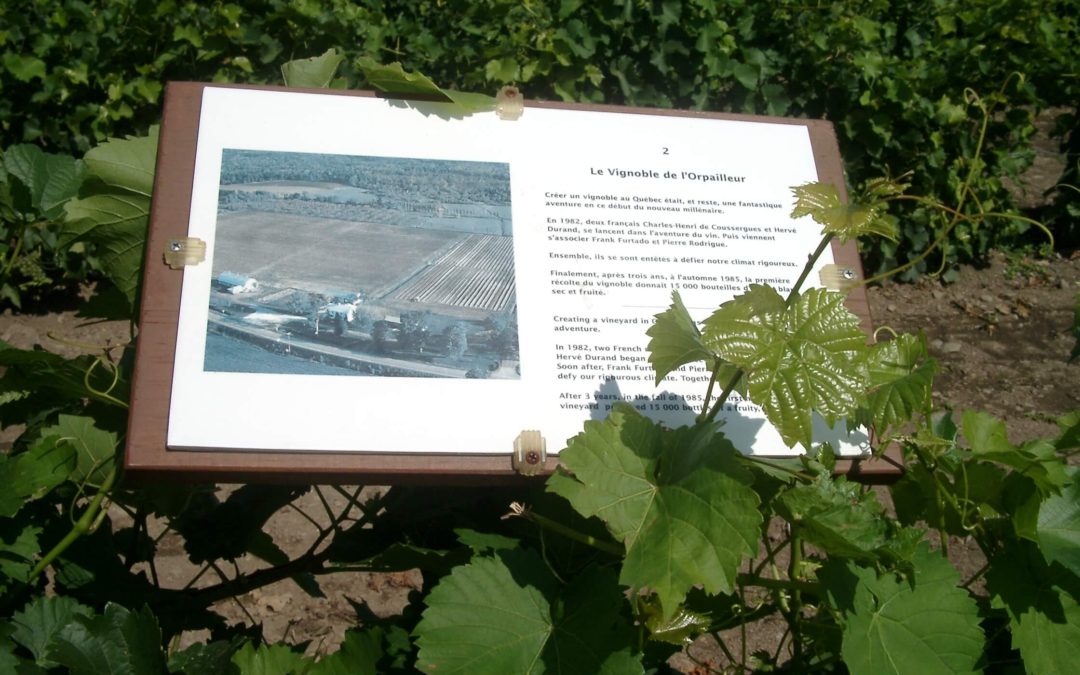Vineyards and wine routes in Quebec
Travels Through Quebec’s Wine Country
By Margaret Swaine
Pouring wine in their rustic 1830 fieldstone and wood beam barn, Iréneé Belley and his wife Sandra Moreau explained how they came to grow wine in a province famous for its cold snowy winters. “I think doing a vineyard will keep the landscape beautiful. People tried to discourage us but I just felt that we needed a lot of money or to be very stubborn.
We didn’t have the first so we needed double the second,” said Sandra. Indeed at Vignoble de la Sablière close to the Vermont border in the Eastern Townships, they must bury the vines under earth every winter to protect them from freezing. With their first plantings in 1996, this vignoble joined a small group of about 28 wineries in Quebec. They’re a hearty lot as are the vines. The vines often spend eight months under snow, buried in earth mounds for protection against bone-chilling -30C temperatures.
This summer I decided to check out Quebec’s newly formed wine tourist route. I was born in Montreal and spent the first twenty years of my life enjoying the ski hills, golf courses and horseback trails of the Laurentians and Eastern Townships. Had there been wineries back then, I’m sure as teenagers with a spirit for adventure, my friends and I would have found them. But the wine trails came after us anglos had all moved out of the province in search of better jobs.
The route meanders along rural roads through wooded valleys by vast lakes with the Appalachian mountains to the south. In the Eastern Townships British and Victorian influenced villages meld with Irish and Scottish tradition and a veneer of colourful Quebecois. The loyalists of New England gave the area its architectural heritage and shaped its face starting in 1775. The French Canadians didn’t arrive until 1850, though from the beginning of the 20th century in two generations they became the majority residents. This rich history of mixed cultures is part of the unique charm of the area.
In the villages baker, butcher and food shops offer fresh baked goodies, homemade pâté and other local foods for the picnicking traveler such as artisan made cheeses. Among my favourites was L’Ermite, a tasty blue cheese produced by the monks of Saint-Benoît -du-Lac at their grand Benedictine abbey above Lac Memphrémagog. You can visit the abbey and buy recordings at their shop of their acclaimed choir reciting Gregorian chants.
Samuel de Champlain who planted vines near Quebec City in 1608 was likely the first to try viticulture in Quebec. His vines didn’t last long. However New France was not to go dry. For example in 1736 records show the colony imported the equivalent of 775,166 bottles of wine for a population of about twenty-four thousand. Attempts continued to be made to introduce viticulture to Canada but it wasn’t until the 1850’s that new hybrid plants from the United States solved the winter kill problem. There was even a vineyard in my old neighborhood, the Beaconsfield Vineyard at Pointe-Claire planted in 1877. However only a few tiny vineyards survived this period, tended by the Trappist monks in Oka and the Cistercians near Rougemont.
In modern times, the first licenses to operate vineyards were issued in 1980. About two dozen others have joined Those original five winegrowers. The province’s two major wine producing areas, the Eastern Townships (Cantons-de-L’est) and Montérégie have over 20 wineries, mostly all located within an hour or less of Montreal. Within the Eastern Townships, in Brome-Missisquoi, an all-new tourist circuit with road signs placed every 10 kilometres marks out the first ‘official’ wine route. It stretches over 132 kilometres taking visitors to 11 wineries. L’Orpailleur, which means gold-panner, is on this tour. It’s one of the original wineries and the largest. I learned my wine history lesson from their self-guided historical look at viticulture in the province. I also enjoyed a tasty lunch at their country-style bistro: Toulouse sausages, salad, a plate of locally made cheeses and pâté all ably accompanied by L’Orpailleur Oak Aged seyval blanc 2002, a fresh fruity white. Their Vin de Glace 2002 was a pure vidal icewine with a peachy apricot and honey taste that was delightful with the maple syrup pie dessert. Also worth more than a sip is their La Marquise de L’Orpailleur, a fortified white that’s macerated with fruits and spices for forty days. This winery is well equipped to handle groups (and they do so) with a film, tour and tasting offered to all.
At Vignoble la Bauge first planted in 1987, the property tour included a visit to their menagerie of boars, llamas, emu, red deer, yaks and more. This mini zoo of 15 different fauna helps draw ten thousand visitors in a season. Inside the winery shop they sold emu oil, goat soap, preserves and wine accessories. Outside, picnic table were set up for light lunches. A mere six dollars bought me a plate of boar and deer sausage, goat cheese in celery along with pâtés of boar and deer spread on rye bread. My choice to go with this savoury assortment was Folie de Vigneron 2002, a vermouth like aperitif wine made with a blend of seyval blanc and prairie star grapes flavoured with lemon and orange peel.
Vignoble La Mission in Brigham is a small family centered winery that makes a delicious vidal icewine as well as clean and fresh table wines. Spanish born Alejandro Guerrero greeted me warmly and offered a tour of his vines, then a visit to his small clean garage like winery with its new but quite manual equipment. When we went to the tasting room, his young daughters came to shyly say hello and help. My favourite visit of all was Domaine des Côtes D’Ardoise in Dunham as it had beautiful gardens dotted throughout with sculptures by some of Quebec’s best artists. They also make the only riesling in the province, a French vinifera varietal. They grow another French varietal, gamay, and I got to try some of it freshly made into wine but not yet bottled. It was lively and delicious but alas I couldn’t convince the winemaker, David Cottineau, to bottle it under its own label. It was to be blended with maréchal foch. Most of the wine in the province is made from hybrid grapes, such as seyval blanc, de chaunac, maréchal foch and vidal. With vines planted in 1975 and their first vintage in 1980, Côtes D’Ardoise has the honour of being the very first winery in modern Quebec. In 1984 it was bought by Dr. Jacques Papillon, a plastic surgeon in Montreal who’s often on TV and is famous for having “done” the breasts of stars in the province.
Montérégie by the south shores of the Saint Lawrence River, is so close to Montreal that it’s home to many commuters. It’s also the number one region for production of apple cider with 14 producers, number one in sugar shacks with 35 and home to 11 vineyards. Clos Saint-Denis in the Richelieu Valley about half an hour from downtown Montreal, makes a fabulous ice apple wine (Pomme de Glace) from their 2,000 apple trees along with a selection of grape based wines and hard ciders on their mile long farm. Among their over 8,500 vines are some varieties that I’ve rarely seen grown anywhere. The eona variety created in South Dakota is winter hardy to -40C, hence the vines don’t need to be buried. They sell it as Cuvée Saint-Denis and it’s fruity, rounded, quite aromatic and certainly interesting to drink. While in this Montérégie area, a must stop is La Cabosse d’Or Chocolaterie where Belgian style chocolates, ice cream and light lunches are made on premises. Their chocolate making is cleverly done behind a glass barrier to allow the public to view. Watching the employees make some of the 60 types of small candies from imported Belgian chocolate certainly motivated me to buy.
Half an hour just northwest of downtown Montreal on the other side of the River is La Roche des Brises in St-Joseph-du-Lac at the start of the Laurentians. One of a few five star gîtes (an upscale bed and breakfast) in the province, this country gem needs to be booked ahead. Its backdrop is another pastoral paradise. The land is dotted with apple orchards, vineyards and ancient farmhouses of stone and sloping tin roofs. It felt like I was stepping back into early Quebec history.
Like elsewhere in the province, La Roche des Brises is surrounded by activity year round. In spring the maple sap runs and sugar shacks open their doors to the public. People flock to them to watch sap turn into maple syrup and enjoy a meal of scrambled eggs, hot dogs, beans and more all drenched in it. In fall it’s apple and grape harvest, the leaves turn brilliant colours and people come to pick their own apples, picnic and sample apple cider and wine. Year round food lovers come for fine regional dining. The 125-seat restaurant at Brises des Bois is beside their wine tasting room with a view of the rolling farmland hills. Owners Gina Pratt and husband Jean-Pierre Bélisle have hired well. Chef André Martin and sommelier/maitre d’ Ivan Blanchette created for me a truly gourmet dining experience. My accommodations were in the gîte across the street in one of their seven large luxurious rooms.
Nearby Ciderie Lafrance offered me samples of a range of their strong (alcoholic) ciders, from sparkling, to still and dry, to sweet apple cider ice wine and a port style one aged in wood. All delicious, I bought a champagne method one and some artisanal cider vinegar to take home. In the fall this place attracts 2,000 visitors on a weekend with its café, live folk music and picnic areas.
Eventually, reluctantly I had to head back to my place in Toronto. My suitcase was stuffed with bottles of ice wine, cider, preserves, chocolates, pâtés and condiments. My nostalgia for La Belle Province will be well soothed by these tasty goodies. And I won’t miss the bone-chilling winters. Those are best enjoyed in small doses as ski vacations. But that’s another story.
Contacts:
L’Orpailleur: www.orpailleur.ca
Vignoble La Bauge: www.labauge.com
A good way to experience regional cuisine is to visit the three elegant country inns of Lake Massawippi; Manoir Hovey, Auberge Hatley and Ripplecove Inn. They all offer fine dining, excellent wine lists and easy access to the nearby wineries.
Hovey Manor: www.hoveymanor.com
Ripplecove: www.ripplecove.com
Auberge Hatley: www.relaischateaux.fr/hatley
Other accommodation in the area:
Auberge Quilliams: www.aubergequilliams.com for large sized rooms, an indoor pool and decent dining
Auberge Knowlton: https://en.aubergeknowlton.com is an historic property right in the heart of the picturesque town of Knowlton
Hostellerie Rive Gauche https://hotelrivegauche.ca/ is in Beloeil on the river and well situated for touring Montérégie. It’s part of the Hôtellerie Champêtre, a fine group of independently owned Quebec resorts and inns www.hotelleriechampetre.com
La Roche des Brises: www.rochedesbrises.com
For details on the wine route, maps and wineries, visit www.bonjourquebec.com
Quebec details: www.bonjourquebec.com (1-877-266-5687) Eastern Townships: www.easterntownships.cc (click on vineyards for winery details) or call 1-800-355-5755 and ask for the new Eastern Townships Tourist Guide that shows the wine route in detail. For the Laurentians: : www.Laurentides.com

